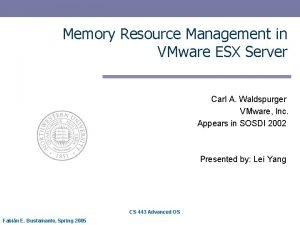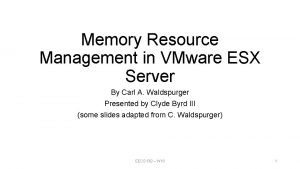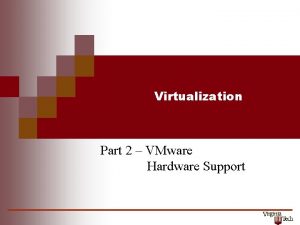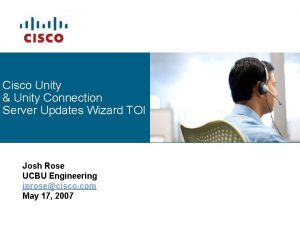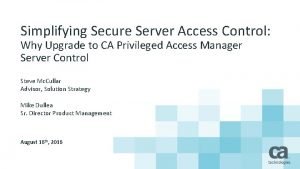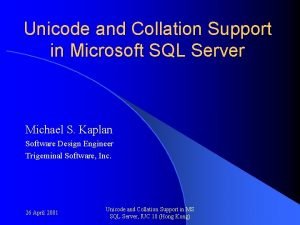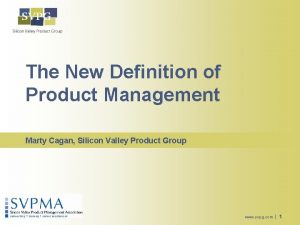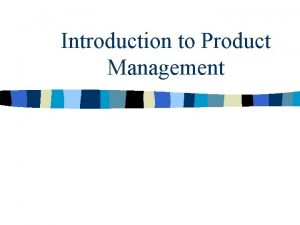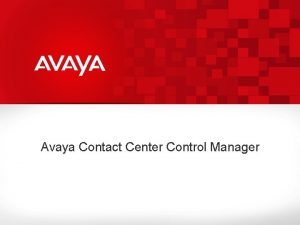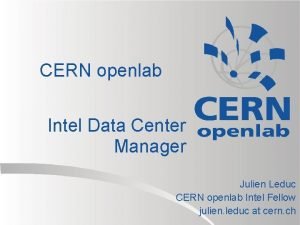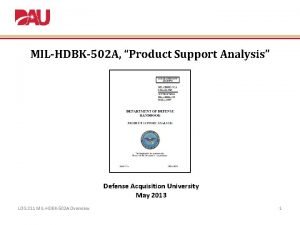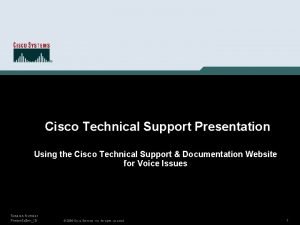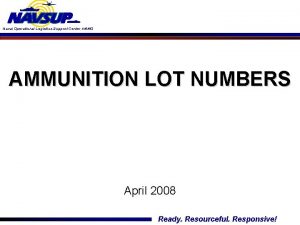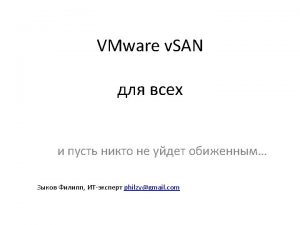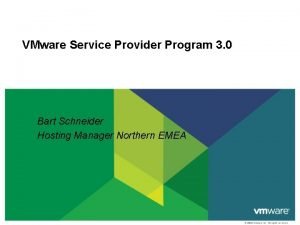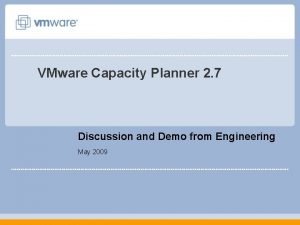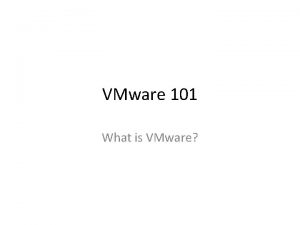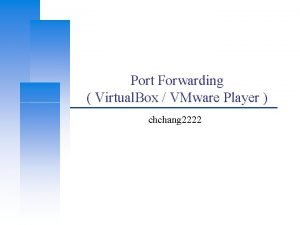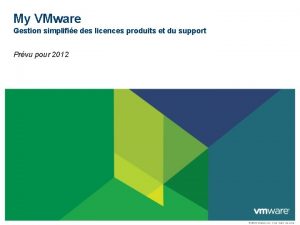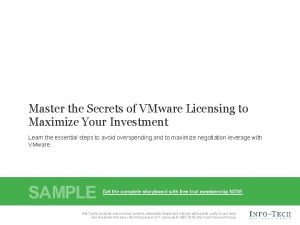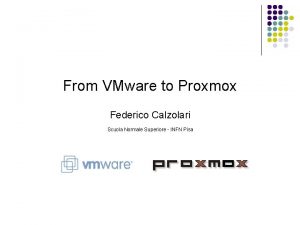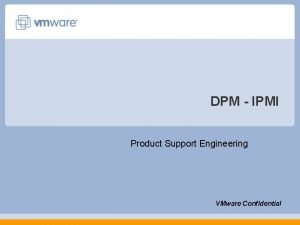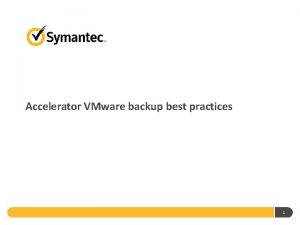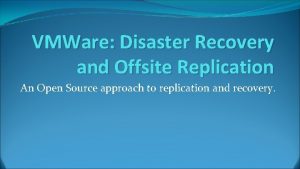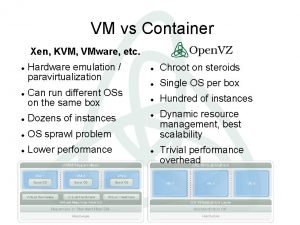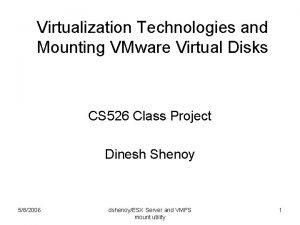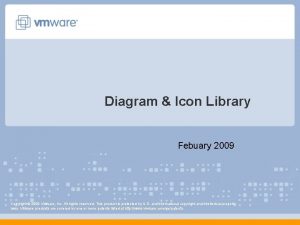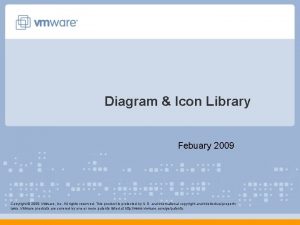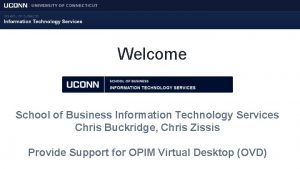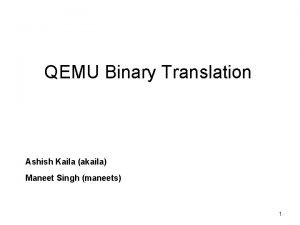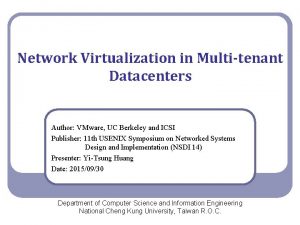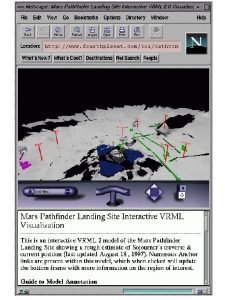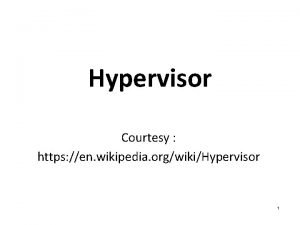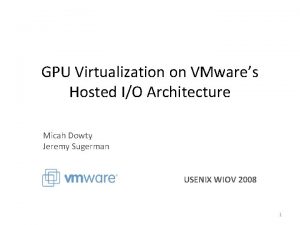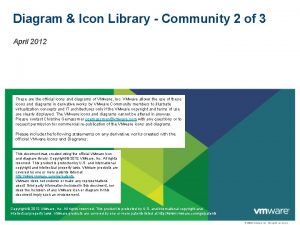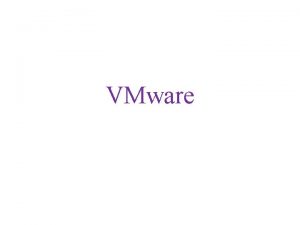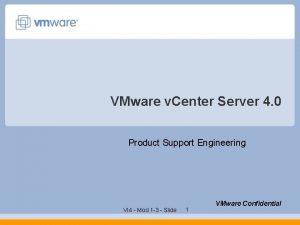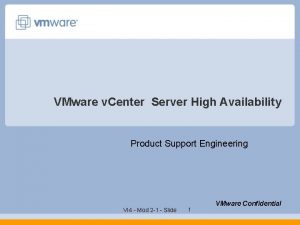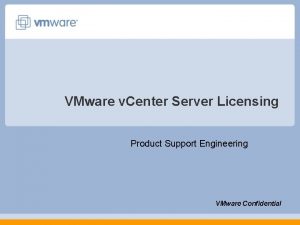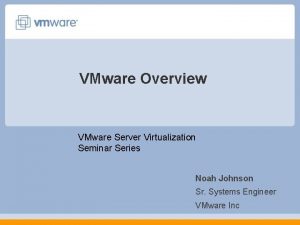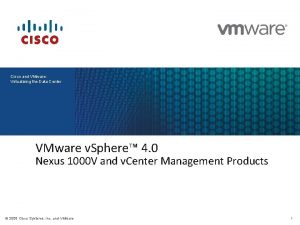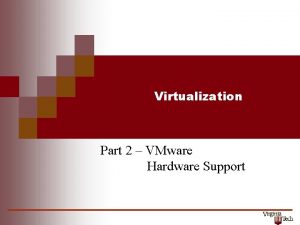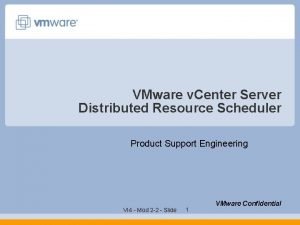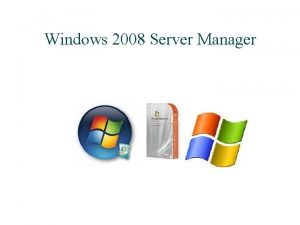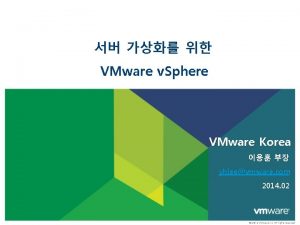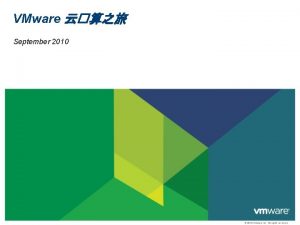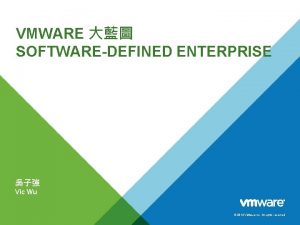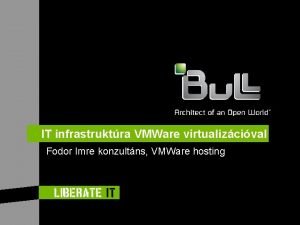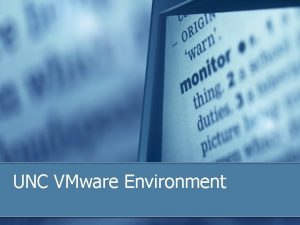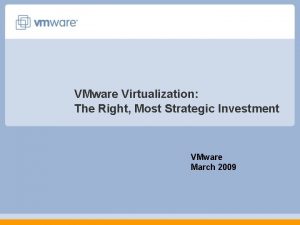VMware v Center Server Update Manager Product Support
































































- Slides: 64

VMware v. Center Server Update Manager Product Support Engineering VI 4 - Mod 2 -10 - Slide 1 VMware Confidential

Module 2 Lessons Lesson 1 – v. Center Server High Availability Lesson 2 – v. Center Server Distributed Resource Scheduler Lesson 3 – Fault Tolerance Virtual Machines Lesson 4 – Enhanced v. Motion Compatibility Lesson 5 – DPM - IPMI Lesson 6 – v. Apps Lesson 7 – Host Profiles Lesson 8 – Reliability, Availability, Serviceability ( RAS ) Lesson 9 – Web Access Lesson 10 – v. Center Server Update Manager Lesson 11 – Guided Consolidation Lesson 12 – Health Status VI 4 - Mod 2 -10 - Slide 2

v. Center Update Manager Overview VMware v. Center Update Manager compares the operating systems and applications running in your VMware Infrastructure deployment against a set of standard updates and patches. Updates you specify can be applied to operating systems, as well as applications on scanned ESX/ESXi hosts, virtual machines, and virtual appliances. v. Center Update Manager works with ESX/ESXi hosts, virtual machines, and virtual appliances. v. Center Update Manager lets you scan for compliance and apply updates for guests, virtual appliances, and hosts. v. Center Update Manager can scan and remediate powered on, suspended, and powered off virtual machines and templates and Scan and Remediate hosts. If the updating or patching fails, you can revert the virtual machines and templates back to their prior condition, without losing data. VI 4 - Mod 2 -10 - Slide 3

v. Center Update Manager Overview You can use v. Center Update Manager to install, patch and update third party software using VI bundles and bulletins available on VMware Patch Portal and third parties’ portals. A VI bundle is a package, the smallest installable unit on an ESX host, while a bulletin defines a specific fix for an ESX 4 host, a roll-up which aggregates previous fixes, or an update release. When a host is compliant with all bundles in a bulletin, it is compliant with the v. Sphere bulletin that contains the bundles. VI 4 - Mod 2 -10 - Slide 4

VMware v. Center Update Manager Sizing Estimator VI 4 - Mod 2 -10 - Slide 5

v. Center Update Manager Supported Databases v. Center Update Manager is supported on the following Databases : VI 4 - Mod 2 -10 - Slide 21

Enabling Update Manager on a v. Sphere Client To enable v. Center Update Manager on a v. Sphere Client Connect the v. Sphere Client to a v. Center Server on which v. Center Update Manager is installed. Choose Plugins > Manage Plugins. VI 4 - Mod 2 -10 - Slide 33

Enabling Update Manager on a v. Sphere Client Complete the v. Center Update Manager client installation and click Finish Click Next on Welcome screen Accept the License Agreement and Click Next Click Install Click Finish VI 4 - Mod 2 -10 - Slide 34

Enabling Update Manager on a v. Sphere Client Right-click VMware v. Center Update Manager Extension in the Installed Extensions list on the Extension Manager page, and choose Enable. Click Close. VI 4 - Mod 2 -10 - Slide 35

Enabling Update Manager on a v. Sphere Client Dismiss any Security Warning dialog boxes that appear by clicking Yes or Ignore, and then click OK. The v. Center Update Manager button might not appear immediately in the v. Sphere Client. After installing the VMware v. Center Update Manager plug-in, if the button does not appear, restart the v. Sphere Client. VI 4 - Mod 2 -10 - Slide 36

Upgrading v. Center Update Manager upgrades are available from v. Center Update Manager 1. 0 to v. Center Update Manager 2. 0 Before you upgrade v. Center Update Manager, be sure to upgrade both v. Center Server and v. Sphere Client to a compatible version. v. Center Update Manager server and v. Center Update Manager client must be the same version. VI 4 - Mod 2 -10 - Slide 37

v. Center Update Manager Network Port Requirements After you install v. Center Update Manager if the default settings are kept during the installation, the v. Center Update Manager Web server listens on 9084 TCP and the v. Center Update Manager SOAP server listens on 8084 TCP. Both are accessed through a reverse proxy that listens on the standard ports 80 and 443. VI 4 - Mod 2 -10 - Slide 41

v. Center Update Manager Network Port Requirements When v. Center Update Manager and the v. Center Server are installed on the same machine: All incoming connections to v. Center Update Manager are accessed through a reverse proxy provided by the v. Center Server. ESX connects to port 80, and the v. Center Server forwards the request to the v. Center Update Manager Web server listening on port 9084 for host patch downloads. The v. Center Server directly connects to v. Center Update Manager on port 8084 because they are on the same machine. v. Center Update Manager connects to ESX on port 902 for pushing the virtual machines patches. VI 4 - Mod 2 -10 - Slide 42

v. Center Update Manager Network Port Requirements When v. Center Update Manager and the v. Center Server are installed on two different machines: v. Center Update Manager has a reverse proxy listening on ports 80 and 443 if the default is not changed during the installation. The v. Center Server connects to v. Center Update Manager through port 443. The reverse proxy forwards the request to 8084. ESX connects to v. Center Update Manager through port 80. The reverse proxy forwards the request to 9084. v. Center Update Manager connects to ESX on port 902 for pushing the virtual machines patches. To obtain metadata for the patches, v. Center Update Manager must be able to connect to http: //www. vmware. com and http: //xml. shavlik. com, and requires outbound ports 80 and 443. VI 4 - Mod 2 -10 - Slide 43

Responding to Failure to put ESX Host in Maintenance Mode To configure how v. Center Update Manager responds to failures to enter maintenance mode Choose Home > Solutions and Applications > v. Center Update Manager. Click the Configuration tab. Under Settings, click ESX Host Settings. Select the Failure response drop-down menu to determine how v. Center Update Manager responds if an ESX host cannot be put in maintenance mode. Choose Retry delay and Number of retries. Click Apply. VI 4 - Mod 2 -10 - Slide 48

Checking for Updates v. Center Update Manager is designed to check for new updates at regular intervals. Gathering current information about updates that are applicable to your environment allows v. Center Update Manager to work as expected. Updates are downloaded according to a single schedule. VI 4 - Mod 2 -10 - Slide 49

Checking for Updates To modify checking for updates Choose Home > Solutions and Applications > v. Center Update Manager. Click the Configuration tab. Under Settings, click Update Downloads. Click the Edit Update Downloads link in the upper-right corner VI 4 - Mod 2 -10 - Slide 50

Checking for Updates Select the type of updates to be downloaded, and click Next. Specify a task name and description. Specify the Frequency and Start Time of the update download, and click Next. (Optional) Specify email addresses Review the Summary page and click Finish VI 4 - Mod 2 -10 - Slide 51

Configuring v. Center Update Manager with an Internet Proxy You can modify v. Center Update Manager configuration settings to work with a proxy server. To modify the proxy configuration through the v. Center Update Manager plug-in Choose Home > Solutions and Applications > v. Center Update Manager. Click the Configuration tab. Click General Edit the default proxy information. If the proxy requires authentication, select the Proxy requires authentication check box and provide user name and password. (Optional) Test the connection. Click Apply. VI 4 - Mod 2 -10 - Slide 52

Configuring Update Manager Network Port Settings After you install v. Center Update Manager, you can configure its port settings to avoid conflicts with other programs installed on the same machine. If v. Center Server is installed on the same machine, you cannot change the HTTP and HTTPS ports. v. Center Update Manager doesn't open these ports, but v. Center Server does. If v. Center Server is not installed on the same machine, v. Center Update Manager starts its own reverse proxy. In this case, you are able to change both the HTTP and HTTPS ports. VI 4 - Mod 2 -10 - Slide 53

Configuring Update Manager Network Port Settings To change the port settings Choose Home > Solutions and Applications > v. Center Update Manager. Click the Configuration tab. Click General Edit the Port Settings Click Apply. VI 4 - Mod 2 -10 - Slide 54

Configuring v. Center Update Manager Patch Download Location When you install v. Center Update Manager, the installation wizard allows you to change the location for downloading patches. To change the location later without reinstalling v. Center Update Manager, you must manually edit the vciintegrity. xml file. To configure the v. Center Update Manager patch download location Log in to the v. Center Update Manager server as an administrator. Stop the v. Center Update Manager service Navigate to the v. Center Update Manager installation directory and locate vci-integrity. xml. The default location is C: Program FilesVMwareInfrastructurev. Center Update Manager VI 4 - Mod 2 -10 - Slide 55

Configuring v. Center Update Manager Patch Download Location Create a backup copy of this file in case you need to revert to the previous configuration. Edit the file by changing the following fields: <patch. Store>yournewlocation</patch. Store> The default patch download location is: C: Documents and SettingsAll UsersApplication DataVMware v. Center Update Manager Data The directory path must end with . Save the file in UTF-8 format, replacing the existing file. Copy the contents from the old patchstore directory to the new folder. Restart the v. Center Update Manager service. Note : You will have to create the directory structure that you specified for <yournewlocation> VI 4 - Mod 2 -10 - Slide 56

Using the v. Center Update Manager Download Service Use the v. Center Update Manager Download Service to initiate downloads of updates and to transfer the updates to v. Center Update Manager. Establish a depot in which to place the updates. After the updates are in the depot, export the newly downloaded updates to some portable storage device such as a CD or USB key and import them to the v. Center Update Manager server. If v. Center Update Manager is installed on a machine that is not connected to the Internet, the scheduled update checks fail. In such a case, disable the scheduled update checks and use the v. Center Update Manager Download Service as the only means to download and transfer updates to v. Center Update Manager. VI 4 - Mod 2 -10 - Slide 57

Setting up the v. Center Update Manager Download Service Log in to the machine where UMDS is installed, and open a terminal window. Change to the directory where Download Service is installed. C: Program FilesVMwareInfrastructurev. Center Update Manager. Specify the updates to download: p p To set up a download of all ESX host updates, enter the following command: vmware-umds --set-config -enable-host 1 --enable-win 0 --enable-lin 0 To set up a download of all Windows updates, enter the following command: vmware-umds --set-config -enable-host 0 --enable-win 1 --enable-lin 0 To set up a download of all Linux updates, enter the following command: vmware-umds --set-config -enable-host 0 --enable-win 0 --enable-lin 1 To set up a download of all available updates, enter the following command: vmware-umds --set-config -enable-host 1 --enable-win 1 --enable-lin 1 4 Run the program to download updates by entering the following command: vmware-umds --download If you want to download the updates released in May 2008, enter the following command: vmware-umds --re-download -start-time 2008 -05 -01 T 00: 00 --end-time 2008 -05 -31 T 23: 59 VI 4 - Mod 2 -10 - Slide 58

Setting up the v. Center Update Manager Download Service Exporting Downloaded Updates You can export the updates you downloaded to a specific location which serves as a shared repository for Update Manager. Then configure Update Manager to use the shared repository as a patch download source. The shared repository can also be hosted on a Web server. VI 4 - Mod 2 -10 - Slide 59

Setting up the v. Center Update Manager Download Service To export downloaded updates Log in to the machine where v. Center Update Manager Download Service is installed and open a terminal window. Change to the directory where Download Service is installed. The default folder is C: Program FilesVMwareInfrastructurev. Center Update Manager. Specify the export parameters. If you want to export all updates for the year 2007, enter the following command: vmware-umds --export --dest <repository_path> --start-time 2007 -01 - 01 T 00: 00 --end-time 2007 -12 -31 T 23: 59 Here, <repository_path> is the full path to your export directory VI 4 - Mod 2 -10 - Slide 60

Creating Baselines You can create upgrade and patch baselines to meet the needs of your specific deployment by using the New Baseline wizard. Creating additional, customized baselines allows patches to be grouped into logical sets. VI 4 - Mod 2 -10 - Slide 63

Create a Dynamic Host Patch Baseline Customize the baseline by entering criteria to filter the list of available patches: p Text contains – Enter text to restrict the updates displayed. p Product – Select operating systems or products for which this baseline includes patches. p Severity – Select the severity of updates to be included in this baseline. p Language – Select which language versions of patches to include. p Released Date – Provide Before and After dates to specify a range for the release dates of the updates. p Update Vendor – Select one of the listed update vendors. p Add or remove specific updates to/from this baseline – Select the check box to add or remove specific updates. VI 4 - Mod 2 -10 - Slide 68

Create a Fixed Host Patch Baseline Review the Ready to Complete page and click Finish VI 4 - Mod 2 -10 - Slide 75

Creating Baselines – Host Upgrade Click Upgrade to available version or Upload upgrade file. Click Next. VI 4 - Mod 2 -10 - Slide 80

Creating Baselines – Host Upgrade If you are upgrading to ESX 4. 0: Specify the location of the service console VMDK or choose to automatically select a location. VI 4 - Mod 2 -10 - Slide 81

Creating Baselines – Host Upgrade Specify the rollback behavior for the upgrade. By default, the host will roll back in the event of an upgrade failure. Deselect the roll back check box to change this behavior. VI 4 - Mod 2 -10 - Slide 82

Creating Baselines – Upgrade File Create a Host Upgrade Baseline Using an Upgrade File You can create an ESX host upgrade baseline by using the New Baseline wizard. This procedure describes how to create a baseline with a specific upgrade file you upload. To create a host upgrade baseline using an upgrade file Choose Home > Solutions and Applications > v. Center Update Manager. Click the Baselines and Groups tab. Click the Create link in the upper-right corner of the page. The New Baseline wizard appears. Provide a name and description for the baseline. VI 4 - Mod 2 -10 - Slide 85

Creating Baselines – Upgrade File Under Baseline Type, select Host Upgrade and click Next. Select Upload Upgrade File, and click Next. Click Browse to locate an upgrade file (. iso) from your local file system, and click Upload. The file might take several minutes to upload. After the file is uploaded successfully, it will be included in the list of available updates on the Upgrade Options page of the wizard. Click Next. Review the Ready to Complete page and click Finish. VI 4 - Mod 2 -10 - Slide 86

Creating Baselines – Dynamic Virtual Machine Customize the baseline by entering criteria to filter the list of available patches: p Text contains – Enter text to restrict the updates displayed. p Product – Select operating systems or products for which this baseline includes patches. p Severity – Select the severity of updates to be included in this baseline. p Language – Select which language versions of patches to include. p Released Date – Provide a range for the release dates of the updates. p Update Vendor – Select one of the listed update vendors. p Add or remove specific updates to/from this baseline VI 4 - Mod 2 -10 - Slide 91

Creating Baselines – Virtual Appliances Create a Virtual Appliance Upgrade Baseline You can create a virtual appliance upgrade baseline using the New Baseline wizard. The virtual appliance upgrade baselines consist of a set of userdefined rules. You can add many non-conflicting rules to a virtual appliance at once. If the rules you create are in conflict, the v. Center Update Manager displays an Upgrade Rule Conflict window, which allows you to resolve the conflicts. VI 4 - Mod 2 -10 - Slide 101

Creating Baselines – Virtual Appliances Select Vendor, Virtual Appliance, and Upgrade To options from the drop-down menus, and click Add Rule. (Optional) To add multiple rules, click Add Multiple Rules: p a Select one or more vendors. p b Select one or more appliances. p c Select one Upgrade To option to apply to the selected appliances. p d Click OK. If you create multiple rules to apply to the same virtual appliance, only the first applicable rule in the list is applied. Click Next. VI 4 - Mod 2 -10 - Slide 104

Create Baseline Groups A baseline group consists of a set of non-conflicting baselines. Baseline groups allow you to create logical sets of patches. You can create additional baseline groups through the New Baseline wizard. When you create a baseline group, keep the following guidelines in mind: All patch baselines can be included in one baseline group. Only one upgrade baseline can exist in a baseline group. Multiple upgrade baselines cannot be included a baseline group. Baseline groups are displayed in the Baseline Groups pane of the Baselines and Groups tab of the v. Center Update Manager plug-in. VI 4 - Mod 2 -10 - Slide 107

Create Host Baseline Groups Select the patch baselines you want to include in the baseline group. (Optional) To create a new patch baseline, click the Create New Host Patch Baseline link at the bottom of the Upgrades page. VI 4 - Mod 2 -10 - Slide 111

Create Host Baseline Groups The Host Baseline Group appears in the Baselines Group list VI 4 - Mod 2 -10 - Slide 113

Create VM and VA Baseline Groups For each type of upgrade (virtual appliance, hardware, and tools), select one of the available upgrade baselines to include in the baseline group. To create a new Virtual Appliance upgrade baseline, click the Create New VA Upgrade Baseline link at the bottom of the Upgrades page. VI 4 - Mod 2 -10 - Slide 117

Create VM and VA Baseline Groups The Virtual Machine / Virtual Appliance Baseline Group appears in the Baselines Group list VI 4 - Mod 2 -10 - Slide 120

Edit an Existing Baseline Group You can change the name and type of an existing baseline group, as well as add or remove the included upgrade and patch baselines of a baseline group. To edit an existing baseline group Connect the v. Sphere Client to a v. Center Server on which v. Center Update Manager is installed, and select Home > Solutions and Applications > v. Center Update Manager. On the Baselines and Groups tab, select the type of baselines to edit. For example, to edit the upgrade baselines for ESX hosts, click the Hosts button and the Upgrade Baselines sub-tab. Select an existing baseline group from the Baseline Groups pane and click the Edit link above the pane. The Edit Baseline Group wizard appears. (Optional) Edit the name and group type of the baseline group and click Next. (Optional) Change the included upgrade baseline (if any) and click Next. (Optional) Change the included patch baselines (if any) and click Next. Review the Ready to Complete page and click Finish. VI 4 - Mod 2 -10 - Slide 122

Scanning VI Objects You can configure v. Center Update Manager to scan virtual machines, virtual appliances and ESX hosts against baselines and baseline groups by scheduling or manually initiating scans to generate compliance information. You can manually initiate a scan of objects in the v. Sphere Client inventory. VI 4 - Mod 2 -10 - Slide 128

Scanning VI Objects - Manually Select the types of updates that the selected object and its child objects will be scanned for. The options are: Patches, Upgrades, and DVS Upgrades. Click Scan. VI 4 - Mod 2 -10 - Slide 130

Scanning VI Objects - Scheduled You can configure the v. Sphere Client to run scans of objects in the inventory at specific times or intervals. To schedule a scan Choose Home > Management > Scheduled Tasks. Click New in the toolbar to open the Select a Task to Schedule dialog box. Select Scan for Updates, and click OK. VI 4 - Mod 2 -10 - Slide 131

Reviewing Scan Results for Inventory Objects To review scan results for inventory objects Select Home > Inventory > object type (for example, Hosts and Clusters or VMs and Templates). Select the object whose scan results you want to view. Click the v. Center Update Manager tab. VI 4 - Mod 2 -10 - Slide 137

Reviewing Scan Results for Inventory Objects The results for scans completed on the object you select appear on the v. Center Update Manager tab. The tab is divided in four panes: p Baseline Groups – Displays a list of the baseline groups attached to the selected object. p Baselines – Displays a list of the baselines attached to the selected object or included in a selected baseline group. p Compliance – Contains a compliance graph that changes dynamically depending on the inventory object you select. Below the graph is a list of the following items: p p p All Applicable – Represents the total number of virtual machines or hosts for which compliance is being calculated. Non-Compliant – Number of virtual machines or hosts that are not compliant with the selected set of baselines and baseline groups. Unknown – Number of the virtual machines or hosts that are not scanned and their state is unknown. Compliant – Number of compliant virtual machines or hosts. Virtual Machines/Hosts – Depending on the objects you select, this pane contains different tables. VI 4 - Mod 2 -10 - Slide 138

Staging Patches for ESX Hosts Staging patches for ESX hosts allows you to download the patches from a remote server to a local server, without applying the patches immediately. To stage patches for remediation Choose Home > Inventory > Hosts and Clusters. Right-click a Datacenter or an ESX host, and select Stage Update. Select the patch baselines and baseline groups to stage. VI 4 - Mod 2 -10 - Slide 139

Staging Patches for ESX Hosts Deselect the patches to exclude. p To view a short summary of the patch, such as title, vendor, product, details URL, vendor assigned ID, release date, and so on, double-click a patch. VI 4 - Mod 2 -10 - Slide 140

Staging Patches for ESX Hosts Select when to stage the selected hosts, and click Next. Review the Ready to Complete page, and click Finish. VI 4 - Mod 2 -10 - Slide 141

Remediating VI Objects You can remediate machines and virtual appliances either through user -initiated remediation or through regularly scheduled remediation. For the ESX hosts in a cluster, the remediation process is sequential. When you remediate a cluster of ESX hosts and one of the hosts fails to enter maintenance mode, the v. Center Update Manager reports an error and the process fails. The remaining ESX hosts in the same cluster that did get remediated stay at the updated level. The ones that were to be remediated after this host are not updated. For multiple clusters under a datacenter, the remediation processes are parallel. If the remediation process fails for one of the clusters within a datacenter, the remaining clusters are still remediated. VI 4 - Mod 2 -10 - Slide 142

Remediating Templates are a type of virtual machine, so they can be remediated. VMware recommends taking snapshots of templates before remediation, especially if the templates are sealed. p A template that is sealed is stopped before operating system installation is completed, and special registry keys are used so that virtual machines created from this template start in setup mode. If errors occur, a template might not be returned to its sealed state. p If v. Center Update Manager loses its connection with the v. Center Server during remediation, the template cannot be returned to its sealed state. p Creating a snapshot before remediation provides for easy recovery from such issues. VI 4 - Mod 2 -10 - Slide 143

Working with Updates To manage the available patches, use the Update Repository tab. The Update Repository tab allows you to see the new patches that are downloaded, as well as the baselines, if any, that a given update belongs to. You can see a table of all available patches. To review the Update Repository Choose Home > Solutions and Applications > v. Center Update Manager. Click the Update Repository tab. VI 4 - Mod 2 -10 - Slide 151

Update Manager Troubleshooting Gathering Log Files To gather information about recent events on the v. Center Update Manager server for diagnostic purposes, use the Generate v. Center Update Manager log bundle functionality that the support script vumsupport. wsf provided. To generate a v. Center Update Manager log bundle Log in to the v. Center Server on which v. Center Update Manager is installed. Choose Start > All Programs > VMware > Generate v. Center Update Manager log bundle. Log files are generated as a ZIP package, which is stored on the current user’s desktop. VI 4 - Mod 2 -10 - Slide 152

Update Manager Troubleshooting No Baseline Updates Available Baselines are based on metadata that v. Center Update Manager downloads from the Shavlik and VMware Web sites. Shavlik provides metadata for virtual machines and applications, while VMware provides metadata for ESX Server hosts. A common reason having no updates available for baselines might be that v. Center Update Manager cannot contact the Shavlik servers. The connection between v. Center Update Manager and the Web site includes several links, the failure of any of which might cause updates in baselines to be unavailable. Some possible causes and solutions include: p Web server proxy misconfiguration. p Shavlik servers being unavailable. Check the Shavlik Web site (http: //xml. shavlik. com) to determine whether it is available. p VMware update service being unavailable to provide information about ESX Server updates. p Poor network connectivity. Check whether other applications that use networking are functioning as expected. VI 4 - Mod 2 -10 - Slide 153

Update Manager Troubleshooting All Updates in Compliance Reports Are Not Applicable The results of a scan might be that all baselines are marked as Not Applicable. Such a condition typically indicates an error in scanning. Examine the server logs for Scan Tasks that are marked as Failed, or retry the scan operation. p If problems persist, collect logs and contact VMware support for further assistance. The results of scans are normally composed of a mix of Installed, Missing, and Not Applicable results. p For example, it is normal for a baseline composed of Linux patches to be Not Applicable to a Windows machine. p Not Applicable entries are typically only a concern when this is the universal result or when it is the result for patches that you know should be applicable. VI 4 - Mod 2 -10 - Slide 154

Update Manager Troubleshooting Remediated Updates Continue to Be Not Compliant For Windows virtual machines, check the registry to make sure that the updates were not installed. Search for the Microsoft Knowledge Base (KB) number that pertains to the update in question. These numbers are in: The virtual machine’s registry in: HKLMSoftwareMicrosoftUpdates<KB_number> The virtual machine’s file system in: C: WindowsNTUninstall<KB_number> Common explanations for this problem include: Insufficient disk space for Service Pack installation. Retry remediation after freeing up disk space. Conflicts with running applications. Reboot the virtual machine and then retry the remediation operation. VI 4 - Mod 2 -10 - Slide 155

Update Manager Troubleshooting Remediating Virtual Machines with All Update or All Critical Updates Fails In some instances, remediating virtual machines with the All Updates or All Critical Updates default baselines fails. This typically occurs in one of the following ways: Remediation fails to complete - To resolve the issue, end the patch process from the Task Manager in the guest. v. Center Update Manager posts events to identify the start and completion of a patch installation, along with the error code. Remediation fails for some patches – Patches might not be readily available. Remediation is completed, but the baseline is still not compliant – This condition might occur when applying patches that subsequently make other patches applicable. VI 4 - Mod 2 -10 - Slide 156

Update Manager Troubleshooting ESX Server Scanning Fails ESX Server scanning typically fails as a result of insufficient permissions or problems with SSL configuration. Check to make sure that the account being used to do the scanning has sufficient permissions and that your SSL connections are properly configured. p Check v. Center Update Manager network port settings. VI 4 - Mod 2 -10 - Slide 157

Update Manager Troubleshooting Events v. Center Update Manager produces events that help you monitor the processes that the system is completing. Check the VMware v. Center Update Manager Administration Guide for a list of these events VI 4 - Mod 2 -10 - Slide 158

Lesson 2 -10 Summary Understand v. Center Update Manager Creating Baselines and Baseline Groups Scanning Host and Virtual Machines Remediating Hosts and Virtual Machines Understand the v. Center Update Manager Download Service Learn how to troubleshoot v. Center Update Manager VI 4 - Mod 2 -10 - Slide 159

Lesson 2 -10 – OPTIONAL Lab 10 OPTIONAL LAB p Creating Baselines and Baseline Groups p Scanning Hosts and Virtual Machines p Remediating Hosts and Virtual Machines p Using the v. Center Update Manager Download Service p Troubleshooting v. Center Update Manager VI 4 - Mod 2 -10 - Slide 160
 Is an alternative of log based recovery
Is an alternative of log based recovery Vmware resource management
Vmware resource management Memory resource management in vmware esx server
Memory resource management in vmware esx server Vmware support hardware virtualization
Vmware support hardware virtualization Unity connection to the update server failed
Unity connection to the update server failed Swhp coverage update center
Swhp coverage update center Senior manager vs general manager
Senior manager vs general manager Portfolio manager synergy manager parental developer
Portfolio manager synergy manager parental developer Secure server access
Secure server access Aam adobe
Aam adobe Patrick olschewski
Patrick olschewski Sql server manager
Sql server manager Data server manager
Data server manager Kereberos
Kereberos V cloud point s100
V cloud point s100 Patient support manager
Patient support manager Sql server unicode collation
Sql server unicode collation Minor and major supporting details
Minor and major supporting details Svpg product manager job description
Svpg product manager job description Introduction to product management
Introduction to product management Product management 101
Product management 101 Referencias bibliograficas
Referencias bibliograficas System center operations manager 2016
System center operations manager 2016 Avaya vector variables
Avaya vector variables System center - virtual machine manager
System center - virtual machine manager Intel data center manager
Intel data center manager Signature product support
Signature product support Mil-hdbk-502
Mil-hdbk-502 Cisco product support
Cisco product support Support center plus
Support center plus Ex libris support center
Ex libris support center Cisco academy support center
Cisco academy support center Ammunition lot number breakdown
Ammunition lot number breakdown Rvc vmware
Rvc vmware Vmware service provider program
Vmware service provider program Vmware capacity planner download
Vmware capacity planner download What is vmware
What is vmware Port forwarding vmware workstation 16
Port forwarding vmware workstation 16 My vmware
My vmware Nhm writter
Nhm writter Vmware ela terms and conditions
Vmware ela terms and conditions Vmware vsp training
Vmware vsp training Start vm proxmox command line
Start vm proxmox command line Ipmi vmware
Ipmi vmware Netbackup accelerator best practices
Netbackup accelerator best practices Zfs trim
Zfs trim Vmware workstation 10
Vmware workstation 10 Vmware offsite disaster recovery
Vmware offsite disaster recovery Vmware backup free
Vmware backup free Xen vs vmware
Xen vs vmware Vmware diskmount utility
Vmware diskmount utility Azure site recovery vmware architecture
Azure site recovery vmware architecture Cuckoo sandbox vm
Cuckoo sandbox vm Sas viya uark
Sas viya uark Gmu vmware
Gmu vmware Vmware icon library
Vmware icon library Vcenterapp
Vcenterapp Uconn vmware
Uconn vmware Qemu binary translation
Qemu binary translation Mycit
Mycit Vmware multi tenant architecture
Vmware multi tenant architecture Cosmo player vrml worlds
Cosmo player vrml worlds Vmware player wikipedia
Vmware player wikipedia Vmware workstation 16 gpu passthrough
Vmware workstation 16 gpu passthrough Vmware icon library
Vmware icon library

